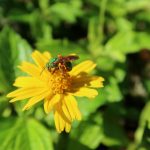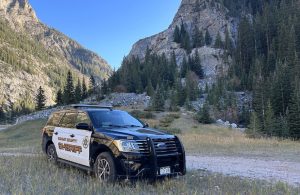Why wildlife might get tangled in your holiday decorations — and how to protect them
Colorado Parks and Wildlife suggests hanging string decorations higher on trees to avoid tangling deer, elk, moose

Chris Dillmann/Vail Daily archive
On Oct. 28, a photo circulated in the Vail Moms Facebook group: An elk was trapped in the front yard of a home in Eagle Ranch, its antlers tangled in string. While it was unclear whether the string was part of the home’s holiday decorations part of another project, it raised an important question: How do we celebrate the upcoming winter holidays while still keeping wildlife safe?
Both preparing for the holidays and protecting Eagle County’s ungulates — hoofed mammals like deer, elk and moose —is possible, as long as decorators take precautions when stringing lights and putting up decor.
Fall behavioral patterns
Animals can become trapped in many types of human-created constructions, including holiday decorations, swing sets, tomato cages and sports-related netting, at any time in the year. Colorado Parks and Wildlife staff typically sees an increase, however, in ungulates becoming trapped during the fall months due to the animals’ behavioral patterns.
Elk, deer and moose lose and regrow their antlers in a yearly cycle. When antlers regrow, they are covered in a fuzzy coating called velvet. In the fall, ungulates shed their antlers in preparation for the rut.
Ungulates may remove the velvet that does not come off easily by rubbing their antlers against inanimate objects, from trees to homes to playgrounds.

Support Local Journalism
“That’s when we tend to see a little bit of that increase of them getting tangled up, especially with volleyball nets, swings, that kind of stuff,” said Rachael Gonzales, public information officer for Colorado Parks and Wildlife.
How much danger are trapped animals in?
Colorado Parks and Wildlife staff has seen instances where ungulates end up with a tire, a tomato plant cage, or something else around their neck. The concern in this situation is that the location of the object “limits their ability to eat, could block breathing,” Gonzales said.
An animal with an item tangled around its antlers, however, is not necessarily at risk for harm.
“It may look really, really bad, but for them, because they have the ability to drop their antlers, sometimes they may just look funny for a while,” Gonzales said. “If people see this, report it, so that we can monitor (the animal).”
Recently, Colorado Parks and Wildlife has been monitoring an elk with construction material wrapped around its antlers in Eagle Ranch. As of now, the elk is “still healthy, still eating, so we’re not going to step in, because it will lose its antlers,” Gonzales said.
Winter behavior for ungulates
In the winter, ungulates’ natural food supply is dwindling and the animals are migrating to lower winter areas, like Eagle.
“As we continue to get more snow, animals are going to migrate down into that traditional winter range,” Gonzales said. “It doesn’t mean that there’s not snow on the ground, it just means that they can get through that snow, that crusted layer, in order to get food.”
Even in winter range areas, food is limited due to the winter season. “It’s so important for us to keep that in mind, because the more calories that they can conserve starting now, the better chance they have for survival as we get through to spring,” Gonzales said.
Heading into winter, wildlife activity starts to decrease as animals slow down and conserve their energy. “This time of year, if we have an animal that’s getting tangled up in decorations, they may exude extra energy to try and get whatever it is off of them, which then burns those extra calories that they need to get through the winter and early spring months,” Gonzales said.
Conserving calories is especially important for females, who may be pregnant through the winter and need a sufficient caloric supply to grow their calves and fawns, which are born in the spring.
Ungulate seasonal migration is also why some Eagle County trails will be closing in the next few days, and why other trails close throughout the winter and spring.
“It’s all part of protecting that winter range and not adding that human presence to animals,” Gonzales said.
Ungulates tend to interpret human presence — particularly if accompanied by a dog — as a threat to their safety, and they will move to areas where there are no people if they notice people around. This both stresses the animals and causes them to burn extra calories, something the trail closures try to prevent.
“You’re going to see some now because that’s traditional winter range, and we don’t want to add that human pressure to that, so that way they can just eat, be happy and conserve those calories to get them through the winter months,” Gonzales said.
Choosing appropriate holiday decorations
Many families are putting up winter holiday decorations around this time of year. Doing so mindfully can help prevent causing unnecessary stress for animals.
“Now that we’re getting into the holiday swing and we’re starting to put up and put out those decorations, think about wildlife, especially the wildlife that tends to be in your area,” Gonzales said. “Any animal can get tangled in something, and so that’s why it’s so important when you are choosing your holiday decorations to keep that in mind.”
Simply stringing decorations higher is one animal-minded decorating strategy. “If you’re thinking about lights on trees, think about, ‘I have moose in the area, maybe I’m going to put those lights a little bit higher so that way they don’t get tangled up in those,'” Gonzales said. “The higher the better for Christmas lights, especially in trees.”
When choosing additional décor, avoid objects that appear — or are — edible.
“We don’t want to be putting out corn or any food-type of decoration, because, one, it’s illegal to feed wildlife, so we want to keep that in mind, but also we don’t want them eating something that’s going to make them sick,” Gonzales said.
What to do if you encounter a trapped animal
If you encounter a trapped or tangled animal, call the Colorado Parks and Wildlife Glenwood Springs office at 970-947-2920.
“We may remove whatever that tangled item is if we think it’s going to impact that animal’s ability to survive, or if we don’t see any impact right away, we’re going to keep an eye on that animal to see what happens,” Gonzales said.
While Colorado Parks and Wildlife officers may not answer immediately — it is still hunting season, meaning their resources are divided — try the line again after a short break, Gonzales said.
“If the phone’s busy or we don’t pick up, give it maybe 30 minutes, because right now, we are in the middle of hunting season, so we’re busy on both sides. If it’s after hours, calling the non-emergency Colorado State Patrol number.”
If you have time, you can keep an eye on the animal from afar. “For your safety, please don’t try and help that animal,” Gonzales said.
If an object does need to be removed, the removal process is “going to depend on the animal,” but will likely involve sedating the animal, Gonzales said. “It’s really going to depend on the situation, and what that level of tangling is. And, again, we may not interfere at all if we feel like that animal can survive and work it off on their own.”
Most importantly, when encountering any type of wildlife, “give it space,” Gonzales said. “Don’t try and get that Instagram photo. You want to get out of there as safely, but as soon, as possible…So keeping that calm presence as you’re slowly backing away, looking at good escape routes (and) enjoy the beauty of that animal.”










